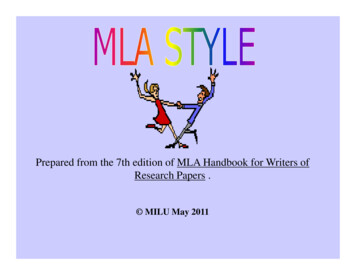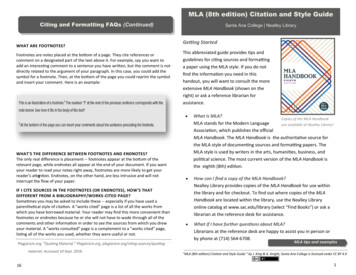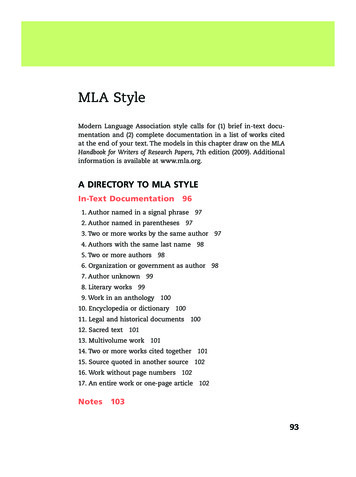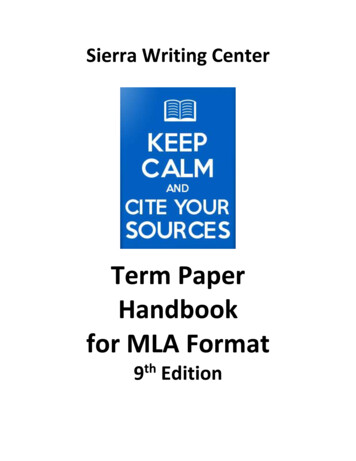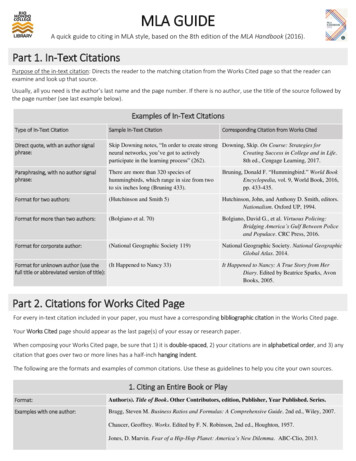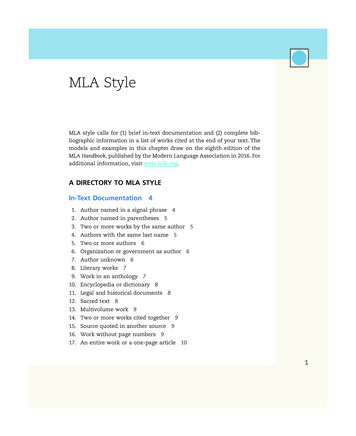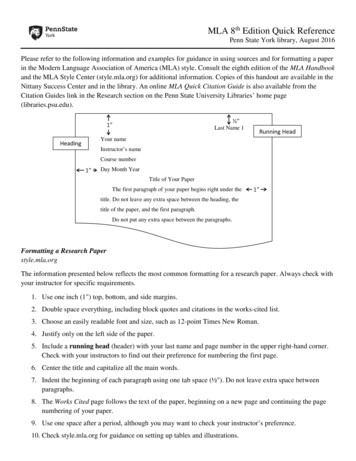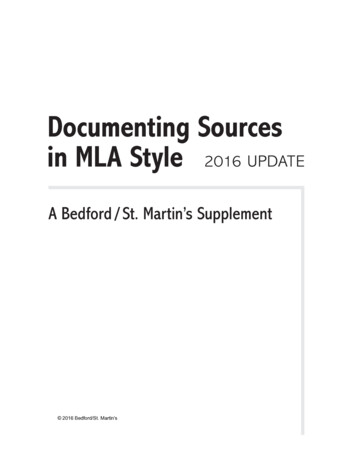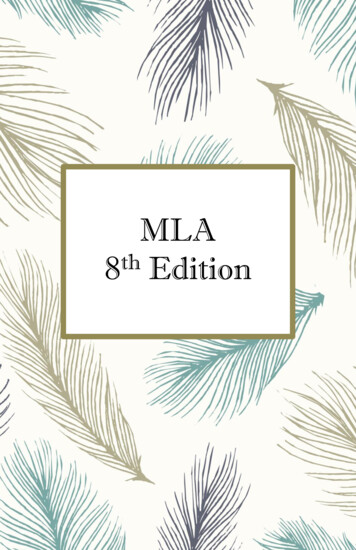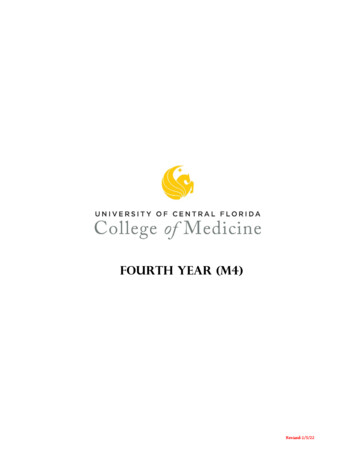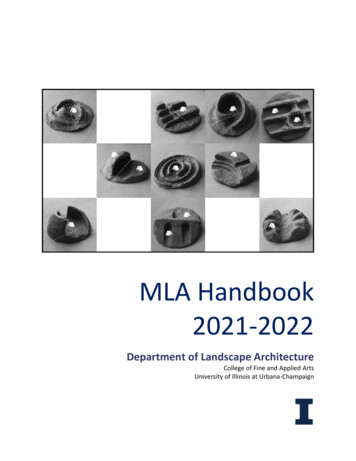
Transcription
MLA Handbook2021-2022Department of Landscape ArchitectureCollege of Fine and Applied ArtsUniversity of Illinois at Urbana-Champaign
Prof. David L. Hays, Brenton H. and Jean B. Wadsworth HeadAssoc. Prof. Mary Pat McGuire, MLA Program ChairDr. Lori Davis, Academic Affairs Coordinator101 Temple Buell Hall611 E. Lorado Taft DriveChampaign, IL 61820Phone:E-mail:Website:(217) inois.eduUpdated: August 11, 2021Cover image: Adele Isyanamanova, “Somnus Park,” LA 438: Design Workshop Studio: Public Power: A NocturnalFuture in the Electric Landscape (Reschke), Spring 2020.2
Land AcknowledgementWe recognize and acknowledge that the University of Illinois is located on the lands of thePeoria, Kaskaskia, Piankashaw, Wea, Miami, Mascoutin, Odawa, Sauk, Mesquaki, Kickapoo,Potawatomi, Ojibwe, and Chickasaw Nations. These lands were the traditional territory of theseNative Nations prior to their forced removal; these lands continue to carry the stories of theseNations and their struggles for survival and identity.As a land-grant institution, the University of Illinois has a particular responsibility toacknowledge the peoples of these lands as well as the histories of dispossession that haveallowed for the growth of this institution for more than 150 years. We are also obligated toreflect on and actively address these histories and the role that this university has played inshaping them. This acknowledgement and the centering of Native peoples is a start as we moveforward for the next 150 years.The UniversitySince its founding in 1867, the University of Illinois at Urbana-Champaign has earned aninternational reputation for its distinguished faculty, outstanding resources and academicprograms, and broad research capabilities.Graduate study is offered in more than 100 programs, and enrollment includes over 18,000graduate and professional students from every state in the United States and from 124countries. Academic resources are among the finest in the world. Along with those of Library ofCongress and Harvard University, the University Library ranks among the largest public andacademic collections in the nation. Its computerized catalog provides easy access to more than14 million volumes and 24 million other items housed in the Main Library, UndergraduateLibrary, 26 departmental libraries, and 7 virtual libraries.The Graduate CollegeThe Graduate College is one of 16 major academic units at the University of Illinois. Staffmembers at the Graduate College work closely with individual students, faculty, and staff toprovide support at all stages of graduate education, from admissions throughthesis/dissertation deposit and degree certification. They also administer fellowships and offerspecial programming to help students compete for prestigious external awards and developstrong professional skills to position them well for future careers. Graduate students andfaculty at Illinois enjoy an intellectual environment that reaches across the arts, sciences,humanities, social sciences, and engineering to create, challenge, and transform knowledge.Our graduate community is international in its composition and global in its impact. TheGraduate College is a member of the Council of Graduate Schools, the Big Ten AcademicAlliance, the Midwest Association of Graduate Schools (MAGS), and the Illinois Association ofGraduate Schools (IAGS).3
The DepartmentThe University of Illinois at Urbana-Champaign was among the first institutions in the nation tooffer an educational program in landscape architecture, with a degree program in place by1907. Today, the Department of Landscape Architecture sponsors one of the leading graduatelevel, research-based design programs in the country. Its first-professional Master of LandscapeArchitecture (MLA) degree program is fully accredited by the Landscape ArchitecturalAccreditation Board (LAAB). Accredited Bachelor of Landscape Architecture (BLA), Master ofSustainable Urban Design (MSUD), and Ph.D. programs are also offered. All four programs areSTEM-designated. The Department has trained some of the best-known practitioners in theUnited States and world, and many of its students have also gone on to teach in and directprofessional programs at US-based and international universities.The faculty of the Department is distinguished globally for wide-ranging scholarly, professional,and creative expertise including community and urban design, ecological and sustainabledesign, architectural and landscape history and methods, cultural heritage, contemporarylandscape theory, social and environmental justice, and public health. Affiliated facultymembers represent numerous University units.Faculty members in the Department devote varying portions of their time to teaching, research,and service at the undergraduate and graduate levels. They bring to the Department a richrange of academic, professional, and personal experiences in regions across the United Statesand abroad. In addition to the tenure-stream faculty, the Department invites prominentscholars and practitioners to participate in the academic programs as lecturers, critics, andvisiting instructors for periods ranging from a day to an entire semester.Opportunities for independent and interdisciplinary study with individual faculty members areavailable in many areas. Such diverse academic pursuits contribute to a dynamic educationalenvironment and complement the diversity of the students themselves, who come from avariety of academic backgrounds.Students, faculty, and staff also interact in a wide range of other ways, including service onDepartment committees, attendance at invited lectures, participation in workshops andcharrettes, activities of the University of Illinois Student Chapter of the American Society ofLandscape Architects (ASLA), all department gatherings at the start of each semester, andannual Sasaki Day events—a design competition, distinguished lecture, banquet, and awardsand recognitions ceremony held on the first Wednesday of May.Additional information may be found at our departmental website:https://landarch.illinois.edu.The MLA ProgramThe objective of the MLA program at the University of Illinois is to provide each student withfundamental skills and proficiency in the core methods of the profession of landscape4
architecture as well as specialization relevant to the central and emergent priorities ofcontemporary practice.Students in the MLA program come from diverse backgrounds in the arts, humanities, andsciences as well as a wide range of design disciplines. Some are recent graduates, whereasothers are experienced design practitioners or second-career aspirants from entirely differentdisciplines. Those with a LAAB-accrediated first professional BLA degree enter our two-yearpost-professional program. Applicants with other backgrounds enter our three-year firstprofessional MLA program. All students who enter without a design background should expecta three-year program that includes prerequisite courses in the foundation skills of landscapearchitecture.Advising for New and Continuing StudentsThe Department of Landscape Architecture is committed to supporting all students in theiracademic, professional, and personal development and to creating an environment in which allstudents feel welcome and comfortable. Academic Afffairs Coordinator Dr. Lori Davis advisesMLA students in selecting classes and navigating institutional processes. She also helps connectstudents with information and resources aimed at supporting their development and success.More information can be found through the Landscape Architecture Advising website.ComputersStudents in the BLA, MLA, and MSUD programs are required to have a laptop capable ofrunning software used in our design programs. Students cannot expect to rely exclusively onuniversity-provided workstations and must have a laptop for in-class tutorials and workshops.Students may choose between a PC or Mac operating system, but the specs should be similar tothose listed below. Students with questions about a specific system/laptop should contact amember of the Department’s Space & Tech Committee for advice. In academic year 2021-22,those members include Prof. Conor O’Shea and Prof. Stephen Sears. While some software isprovided, students should also expect to purchase an Adobe Suite subscription ( 20/month)and a copy of Rhinoceros 3D ( 199 one time purchase). Note: The College of Fine and AppliedArts uses PCs. While Mac operating systems generally work as well, there may occasionally beextra steps to using a Mac computer.PC Option 1 (17.3” screen): (approx. 2,800)Model: Dell Precision 7750 Mobile Workstation (17.3” screen) Processor: Intel Core Processor i9-10885H (8 Core, 16MB Cache, 2.40 GHz to 5.30GHz, 45W,vPro) Graphics Card: NVIDIA Quadro RTX 5000 w/16GB GDDR6 RAM: 16 GB (minimum) RAM: 32 GB (recommended) Display: 17.3" FHD, 1920x1080, 60Hz, Anti-Glare, Non-Touch, 100% DCIP3, 500Nits,WVA,IRCamMic/WLAN Storage: 512 GB Solid State Drive (Minimum)5
PC Option 2 (15.6” screen): (approx. 3,000)Model: Dell Precision 7750 Mobile Workstation (15.6” screen) Processor: Intel Core Processor i9-10885H (8 Core, 16MB Cache, 2.40 GHz to 5.30GHz, 45W,vPro) Graphics Card: NVIDIA Quadro RTX 5000 w/16GB GDDR6 RAM: 16 GB (minimum) RAM: 32 GB (recommended) Display: 15.6" FHD, 1920x1080, 60Hz, Anti-Glare, Non-Touch, 100% DCIP3, 500 Nits,WVA, CamMic/WLAN Storage: 512 GB Solid State Drive (Minimum)Mac: (approx. 2,800)Model: MacBook Pro 16” Processor: 2.6GHz 6 core 9th generation Intel Core i7 processor, Turbo Boost up to4.5GHz (minimum) Processor: 2.4GHz 8 core 9th generation Intel Core i9 processor, Turbo Boost up to5.0GHz (recommended) Graphics Card: AMD Radeon Pro 5300M with 4GB of GDDR6 memory (minimum) Graphics Card: AMD Radeon Pro 5500M with 8GB of GDDR6 memory (highlyrecommended) RAM: 16 GB Memory (minimum) RAM: 32 GB Memory (recommended) Storage: 512 GB Solid State Drive (Minimum)MLA CurriculumThe MLA curriculum comprises a wide range of studio-, lecture-, seminar-, and lab-formatcourses that engage students in design, representation, history, theory, materials, andtechnology. Required lecture-, seminar-, and lab-format courses provide essential informationabout critical issues and methods, and studios provide opportunities to apply and explore thosethrough design. MLA students also develop specialization through one of two tracks: electivecoursework or a thesis.To ensure that core knowledge and experiences are gained by first-professional MLAcandidates, the MLA curriculum also includes required prerequisite foundation courses.Prerequisite courses are waived only when high-quality, equivalent work elsewhere (throughformal study or experience) can be demonstrated, as through transcript review, referenceletters, and/or results of proficiency exams. Students may complete a course waiver petitionform (available on the Landscape Architecture Advising website) to request a course waiver.Only the Academic Affairs Coordinator, in consultation with the MLA Program Chair, may waivecourses. Approval of any waiver(s) will be recorded in the student’s academic file.Prerequisite and other required courses must be taken for a grade; credit-no credit is not anoption for those.6
Course of Study and Degree RequirementsAll MLA students must complete a minimum of 48 credit hours of graduate work (courses with400- or 500-level numbers): A minimum of 24 credit hours must be in 400- or 500-level landscape architecturecoursework. At least 18 credit hours must be at the 500 level (in any subject). Up to 8 credit hours of LA 590 Directed Research may be counted towards thisrequirement. Students in the thesis track, are required to complete a minimum of 10 credit hoursof LA 599 Thesis Research. Credit is not awarded for hours in excess of 10.As a core requirement, all MLA students must successfully complete: LA 501 Landscape Architecture Theory & Practice LA 513 History of World Landscapes LA 533 (prev. 537) Planning & Design Studio I LA 534 (prev. 438) Design Workshop G-I LA 597 Research Design & Methods Ecology course (400- or 500-level; 3 credits or more) Methods course (400- or 500-level; 3 credits or more) Social/Cultural Issues course (400- or 500-level; 3 credits or more)Students may complete a professional internship for 0 to 5 hours of academic credit. Typically,this is completed in a summer semester.LA 501 Landscape Architecture Theory & Practice is taken by all MLA students in their firstsemester of study. Students must complete LA 501 before enrolling in LA 597 Research Design& Methods.LA 597 is taken by all MLA students in their penultimate spring semester of study. The purposeof LA 597 is to assist students in choosing their path to specialization: through electivecoursework or a thesis.All MLA students are required to complete one ecology course, one methods course, and onesocial/cultural issues course at the graduate-level (400- or 500-level) and for a minimum of 3credit hours each. See the Academic Affairs Coordinator for a list of recommended courses.Courses not on that list may be chosen with approval of the Academic Affairs Coordinator (inconsultation with the MLA Program Chair). Some courses may be approved for more than onerequirement; however, one course cannot be used to satisfy more than one requirement.Selection of ecology, methods, and social/cultural issues courses should reflect professional andspecialization interests. Students are advised to review course descriptions carefully forprerequisites and to contact the instructor with concerns/questions. Not all courses are offeredevery year. If you are interested in a certain course, check the course catalog for more7
information or contact the unit offering the course. Depending on the topic, elective coursesoffered by the Department may be used to meet the ecology, methods, and/or social/culturalissues course requirements with pre-approval of the Academic Affairs Coordinator.SpecializationDuring their course of study, MLA students develop specialization that reflects their interestsand career aspirations in keeping with the wide range and rich potential of contemporarylandscape architecture. Examples of specialization undertaken by past graduates include, butare not limited to, community and urban design, ecological design, cultural heritage, digitaltechnology, history and design, historic preservation, public health and well-being, energysystems and infrastructure, social and environmental justice, and landscape-based practices ofart.During their initial semesters of study, students explore specialization through electivecoursework and personal foci within required courses. During their final semesters of study,each MLA student pursues specialization through one of two tracks: elective coursework or athesis. Each of those involves 10 credit hours directly, but both build upon other courseworkcompleted.In all cases, specialization involves the development of in-depth understanding of theoreticaland practical issues pertinent to the area of inquiry, including critical questions and concerns,historical and conceptual models, and potential implications. Work is undertaken in the media,formats, and range of scales appropriate to the area of inquiry.Specialization through CourseworkAs a path to specialization, MLA students may undertake graduate-level elective courseworkplus a second Design Workshop: Graduate-level (400- or 500-level) elective coursework (5 credit hours) LA 539 (prev. LA 438) Design Workshop G-II (5 credit hours)Choice of specialization-based elective coursework is determined in consultation with theAcademic Affairs Coordinator and the MLA Program Chair. Note: LA 537 Planning & DesignStudio II may be taken as the specialization-based elective, and work pursued within thatcourse should reflect as closely as possible the chosen area of specialization. The choice of LA539 section and individual work pursued within that should also reflect as closely as possiblethe chosen area of specialization.Before the end of their terminal semester, each MLA student specializing through courseworkmust prepare and submit to the Department a two-page document (approx. 500 words)describing their specialization and relating it to specific courses undertaken and individual workcompleted within those. See Academic Afffairs Coordinator Lori Davis for detailed informationon the format of the document and how to submit it.8
Specialization through ThesisAs a path to specialization, MLA students may undertake a thesis: LA 597 Thesis Research (2 semesters; 5 credit hours each)Working under the supervision of a faculty advisor (aka chair), a thesis student must pursue indepth, independent work of relevance to landscape architecture and accomplishing one ormore of the following goals: Demonstrate an innovative application of knowledge within the field Analyze, critically examine, and/or empirically test ideas/theories Creatively synthesize, expand upon, and/or develop designs/theoriesThe thesis provides for a complete expression of ideas through a broad range of products thatmay include a design, an experiment, a management plan, a textual analysis, or a researchmodel. A thesis proposal must clearly explain how the work will accomplish at least one of thegoals listed above. The completed thesis must reasonably justify that this has been achieved.The format should be an appropriate complement of written and visual materials, inproportionate amounts to be determined by the nature of the project. The same effort,intellectual rigor, and quality of work are expected regardless of the approach, products, and/orformat.Topic Selection Developing a thesis topic requires careful thought and investigation. Studentsshould rely on their previous experience and coursework to identify topics that are personallyinteresting and suitable for graduate study.Proposal Thesis proposal development is support in LA 597 Research Design& Methods.Through that process and consultation with instructors and other relevant experts, the studentshall identify a topic and question of interest and prepare a proposal that describes those aswell as the work to be undertaken. The proposal should contain an introduction to the topicand question to be explored, justification for and purpose of the study, a critical literaturereview, proposed method(s), and, if appropriate, the type of documentation to be developed. Aschedule of anticipated steps for completing the work should also be prepared. A copy of theapproved proposal and a completed Thesis Proposal Approval form must be submitted to theDepartment via the MLA Program Chair.Committee Each thesis committee shall be composed of three faculty members. The studentmust identify an appropriate faculty member to supervise the work (the thesis committeechair) and secure that faculty member's acceptance of the responsibility. The thesis committeechair must be both a member of the Landscape Architecture faculty and a member of theGraduate Faculty. Other members of the committee need not be members of the LandscapeArchitecture faculty or the Graduate Faculty. If the chair holds a zero-time appointment in theDepartment, at least one of the other committee members must hold a full-time appointment9
in the Department. The chair and other committee members should be selected for interest inthe topic and special expertise that will contribute to the development of the thesis. Whenappropriate, students are encouraged to invite faculty members from other departments toserve on their committees. One non-University member may serve on a committee whenapproved by the chair and the MLA Program Chair. Before selecting a chair and committeemembers, students should inquire about scheduled sabbaticals and planned leaves of absence.The thesis committee chair is responsible for working closely with the student throughout theentire thesis process, providing appropriate direction and advice on a regular basis. The othertwo committee members will normally play lesser roles by providing support in their areas ofexpertise. Regardless of responsibilities, the chair should be consulted regularly and willdetermine if the thesis is ready for review.LA 599 Thesis Research Only those students who have completed LA 597 and who have anapproved thesis proposal and the support of a chair and committee may enroll in LA 599 ThesisResearch. Each thesis student enrolls in the section of LA 599 Thesis Research specific to theirchair. Thesis students are expected to enroll in LA 599 Thesis Research during the first twosemesters after their thesis proposals are approved. In LA 599, each student will undertake andcomplete thesis research and creative and/or scholarly exposition. Each thesis committee willhelp guide and critique student work; however, it is each thesis student’s responsibility to makesatisfactory progress. Thesis students enroll in a total of 10 hours of LA 599 divided over twosuccessive semesters. Any hours of LA 599 beyond the required 10 will not count towardscompletion of degree requirements.Funding for Thesis Research The Graduate College provides information about fellowships andgrants that may pertain to thesis research as well as conference travel support. Deadlines occuronce per semester, and awards are made through competition. The Department also offersseveral travel fellowships that can be used to support thesis research. For more informationand instructions on how to apply, see the call for applications issued by the Department eachspring semester.Thesis Format The Department does not restrict theses to the traditional written format.Drawings, models, videos, and/or other media are acceptable along with text components. Theproportion of content in different formats is to be determined by the nature of the project.Generally, when the bulk of the thesis is in non-written format, the written portion of the thesisshould allow readers to understand the content and significance of the thesis along with itsformat, sources of information, and the methods used to develop its conclusions. In caseswhere such information is contained in the non-written portion, the written part shall consist ofthe abstract, a description of the format of the non-written part, and any pertinent notesconcerning means of retrieval. Additional information about acceptable formats is availablethrough the Thesis Office of the Graduate College. See https://grad.illinois.edu/thesis.Thesis Editing The thesis committee chair or other committee members may require thestudent to consult the University’s Writing Center and/or to engage an editor to improve the10
writing style and to correct grammatical, spelling, and punctuation errors in the thesis. Anyexpenses associated with thesis editing must be borne by the student.Thesis Committee Reviews When the thesis committee chair determines that the thesis iscomplete, the student will meet with the entire committee to review and evaluate the work.Other preliminary reviews may be scheduled at the request of the student and/or as the chairor members see fit.Departmental Approval When the thesis is completed and ready for approval and deposit,the student completes the Thesis/Dissertation Approval (TDA) form and gives it first to thethesis committee chair, then to the other committee members, and finally to the DepartmentHead (or designee) for final review and signatures. All signatures (chair, other committeemembers, and Department Head) must be acquired in that order, and all are required fordeposit approval. The chair determines when it is appropriate to submit the thesis to the othercommittee members and the Department Head. The Department Head will evaluate the thesisand, if necessary, negotiate any differences with the thesis committee chair. After the thesishas been approved and the Thesis/Dissertation Approval form signed, a copy of the thesis mustbe submitted to the Departmental thesis reviewer for a format check. This step helps ensurethat the submission will not be rejected by the Graduate College for technical reasons. In 202122, the reviewer will be Office Manager Marti Gortner.Submission to the Graduate College for Review and Deposit The thesis is submittedelectronically to the Graduate College for approval and deposit. The student is solelyresponsible for depositing the completed thesis to the Graduate College in accordance withtheir schedules and procedures and for meeting the Graduate College requirements regardingthesis format. See the Graduate College’s thesis deposit guidelines for details. Upon successfuldeposit, the thesis student should deliver a copy of the final thesis document to eachcommittee member.Deadlines for Deposit Deadlines for deposit are updated and published online by theGraduate College. Normally the Graduate College undertakes thesis format reviews up to andincluding the day of the deposit deadline. However, students are strongly encouraged to send acopy of their title page to the Graduate College Thesis Office for review well in advance ofanticipated deposit and to submit as far as possible in advance of the deadline. If the thesis isnot deposited and accepted by the Graduate College by the deadline, the student will officiallygraduate at the first graduation period after the thesis has been acccepted. To meet deadlinesfor deposit, grade submission, and graduation, each thesis student should allow sufficient timefor committee, Department, and Graduate College review. Students should remember thatmembers of the faculty are normally not on appointment during the summer and are usuallyunavailable for thesis consultation. Work to be conducted during the summer will requirespecial prior arrangements.Thesis Evaluation/Grading LA 599 is graded satisfactory (S) or unsatisfactory (U). The grade isassigned by the thesis committee chair and should reflect the consensus of the thesiscommittee members.11
Graduate MinorsThere are numerous, optional Graduate Minors outside of Landscape Architecture whichstudents may pursue.Joint MLA/MUP ProgramA joint degree is a campus-approved program in which a student concurrently pursues twospecifically identified degrees, and those degrees are conferred simultaneously. TheDepartment of Landscape Architecture and the Department of Urban & Regional Planning offera joint MLA/MUP program. Students interested in pursuing the joint program should consultboth departments as they must be admitted separately to each program.Students in the joint MLA/MUP must be enrolled in each unit program alternately for at leastone academic year after admission, and they must complete the requirements for each degree.For ease of scheduling and meeting requirements, students in the joint degree programtypically focus on one program in any given semester. It is department policy not to fundstudents in the joint degree program during the time they are enrolled in the alternateprogram.Limited / Full StandingApplicants with grade point averages of at least 3.00 (on a 4.00 scale) for the last sixty hours ofundergraduate study are admitted to the MLA Program with full graduate standing. Applicantswith grade-point averages below 3.00 are rarely considered for admission. If admitted, suchstudents are placed on limited status, meaning probationary admittance with elevation to fullgraduate standing contingent upon successful completion (minimum 12 hours and a GPA of atleast 3.00) of the first semester in the program.Students who are required to demonstrate English proficiency through TOEFL or IELTS scoresmust obtain a TOEFL score higher than 102 or IELTS scores higher than 7 to be admitted on fullstatus. Students who are required to demonstrate English proficiency and score lower than thisare admitted on limited status pending completion of one or two English as a Second Languagecourses as determined by the English Placement Test upon arrival to campus. In keeping withGraduate College policy, fellowship and assistantship opportunities are not available tostudents on limited status.Graduate College/Department Minimum Grade Point AverageSee the Graduate College Policy on Academic Standing in section 3.2 of the Graduate CollegeHandbook.12
Annual Academic Progress ReviewsIn accordance with Graduate College policy, the Department of Landscape Architectureconducts annual reviews of all MLA students. An annual review helps each student progressthrough the program by allowing timely identification of deficiencies, clarification ofexpectations for academic performance, and identification of opportunities for improvement.At the end of each year, the Academic Affairs Coordinator will present information to the MLAProgram Chair and Department Head about the status of each student. This will include thenumber of semesters in the program, GPA, and, when appropriate, identification of the thesischair and other thesis committee members.Per Graduate College policy, a graduate student must be making satisfactory academic progressto hold an assistantship.Degree Completion and GraduationTo obtain the MLA degree, each student must complete all requirements within five years oftheir initial enrollment in the program. After that time, requests to complete degreerequirements will be denied.August and December graduates are welcome to participate in the first May departmentalcommencement ceremony occurring after the MLA degree is conferred. Students who wish toparticipate in the May departmental commencement ceremony prior to degree conferral mustbe in good standing and on track to graduate by the following August or December.Financial AidOpportunities for merit-based financial aid—including assistantships, fellowships, scholarships,and prizes, some of which provide tuition and partial fee waivers—can be found on theDepartment’s website. It is Depar
MLA Handbook 2021-2022 Department of Landscape Architecture College of Fine and Applied Arts University of Illinois at Urbana-Champaign . 2 Prof. David L. Hays, Brenton H. and Jean B. Wadsworth Head Assoc. Prof. Mary Pat McGuire, MLA Program Chair Dr. Lori Davis, Academic Affairs Coordinator
